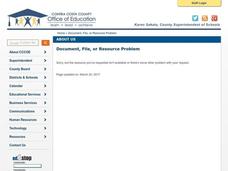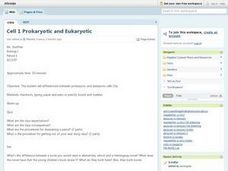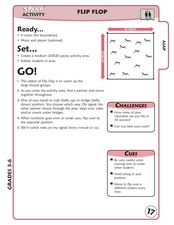Curated OER
Hip Hip Hooray for Expression!!
Students identify what it means to be fluent and that there are five components: reading faster, reading with expression, reading smoothly, reading silently and being able to read voluntarily. Then they focus on being able to read with...
Curated OER
Bee and Dee
Young scholars practice discerning between the letters D and B. Through listening and writing activities, they recognize the difference between the commonly confused letters B and D. They practice writing both letters and correcting...
Curated OER
Candy Math
Second graders in a special education classroom sort candies by color. In groups, they complete various addition problems with the candy and create graphs. They compare and contrast the amounts of candies and answer questions on a...
Curated OER
Cell 1 Prokaryotic and Eukaryotic
Students differentiate between prokaryotic and eukaryotic cells. They examine pictures of prokaryotes and eukaryotes and write down the differences between the two. They complete a Venn Diagram on the cells.
Curated OER
Where Does Your Water Come From?
Pupils engage in a instructional activity to determine the source of water that is used. They conduct research using a variety of resources. The instructional activity includes information for the teacher to share with the class....
Curated OER
Not So Snappy 9
In this order of operations (i.e., addition, subtraction, multiplication, division) worksheet, learners solve 4 word problems demonstrating their understanding of the concept.
Curated OER
Recognize Triangles
In this shapes worksheet, students are asked to "colour" all of the triangles they find on the page. There are 10 shapes on the page and 4 are triangles. The second page contains suggestions for teachers on activities with 2-D shapes.
Curated OER
Point Graphs
Students experiment with point graphs. In this math lesson, students are divided into groups and perform an experiment to see how high a ball bounces, recording their results on a point graph. Students then answer provided questions.
Curated OER
Rosa Parks
Young scholars explore the life and works of Rosa Parks. In this Civil Rights lesson plan, students consider Rosa Parks' work as a philanthropist. Young scholars then write a letter to someone that they admire for making a difference.
Curated OER
Flip Flop
Pupils participate in a stretching warm-up exercise. In this physical education lesson, students warm up the large muscle groups by standing on their hands and legs in a belly up position or a belly down position. Pupils flip their...
Curated OER
Boy Cricket Girl Cricket
Students investigate crickets. In this series of cricket activities, students observe and chart crickets. Students discuss the differences between male and female crickets, record findings in a journal, handle crickets, and read a...
Curated OER
Composition of Functions
Students solve problems using the composition of functions. In this algebra lesson, students analyze the graph of a quadratic equation for its vertex and intercepts. they find the inverse of the function using addition, subtraction,...
Curated OER
Math and Circumference
Sixth graders explore geometry by utilizing mathematical formulas. In this circumference activity, 6th graders identify the difference between diameter, circumference and radius in a circle. Students review the formulas for finding...
Curated OER
Movie Making
Students use a program titled Movie Maker to create movies on the computer. In this movies lesson plan, students create scenes, add background music, and more.
Curated OER
Are There Really Fifty-Three Nations Within Africa?
Students color a map showing that Africa consists of 53 nations and recognize the difference between a nation and a continent. The main objective of this lesson is for students to realize that Africa is a continent with many nations...
Curated OER
"The Outsiders" by S.E. Hinton
Middle schoolers estimate the distance in miles between Tulsa, Oklahoma and Manhattan, Kansas. They gather and graph data on gangs in both areas.
Curated OER
Using Science to Explore
In this science technology learning exercise, students will read about how robots have helped scientists explore areas that humans cannot. Students will complete 2 short answer questions based on the reading.
Curated OER
Not So Snappy 4
In this order of operations (i.e., addition, subtraction, multiplication, division) worksheet, students solve 4 word problems demonstrating their understanding of the concept.
Curated OER
Trash or Treasure?
Students identify things that can be reused. In this environmental lesson, students read the poem "Hector the Collector" and discuss the difference between junk and treasure. Students complete a reflection about what they read by...
Curated OER
Medical Terminology
Pupils analyze specific medical terminology. In this medical terminology lesson, students research medical terminology and write properly grammatical paragraphs on each word including the scientific term, nursing and general definitions,...
Curated OER
Newspapers or Television: What's Better?
Students compare newspapers to television news and decide which they prefer. In this newspaper and television lesson, students read an article and watch a video of the same event. Students discuss the differences, forming an opinion on...
Carnegie Mellon University
Battery Workshop
Introduce your class to the workings and parts of a battery-operated circuit. Pairs of pupils use lemons to make batteries and measure voltage and current with a multimeter. An accompanying worksheet is used for recording values and...
Have Fun Teaching
Compare and Contrast Greek Myths (4)
How are Icarus and Prometheus similar? How are they different? Compare any two Greek myths with a graphic organizer, which provides space for kids to fill in the ways that the myths are like and unlike each other.
K12 Reader
Change Adjectives into Adverbs
What do you need to turn an adjective into an adverb? Sometimes you need an -ly, but there are other endings. Ask your learners to change the endings of 29 adjectives in order to transform them into adverbs and complete the provided...

























